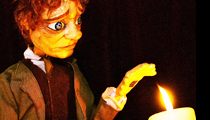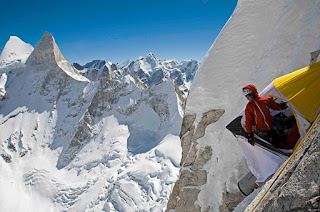Parvez Sharma's A Sinner in Mecca - described as a hajj of defiance, screened at this year's Sheffield DocFest earlier this year, to a full house.
 |
| theguardian.com |
Sharma had a lot to live up to following his previous film 'A Jihad for Love' where he documented the lives of gay, lesbian and transgender Muslims, who choose to remain faithful to Islam, and some in countries where many would choose to flee. Sharma decided it was time to fulfil his Hajj, only he had a secret, Parvez Sharma is a gay man, which carries with it more than the threat of being caught with a camera, but also the threat of death. Sharma confesses, 'I was done coming out as a gay man, I needed to come out as a Muslim' and that is exactly what A Sinner in Mecca set out to do - all-be-it rather indignantly. The 79min film is almost entirely shot on an Iphone, with various rules in place that would make it difficult to film on anything less discreet.
 |
| outlandic.com |
However, if the aim was to prove himself as a Muslim, to come out devout to his faith, I felt that from start to finish the film was riveted with skepticism and tied together only by a slightly biased reaction to an only partly-authentic journey. Of course I expected him to be on his guard, he was filming and hiding the fact he was a gay man. Sharma has even received personalised death threats following the world premiere of his film in Canada. He does however, hold some form of a grudge against the faith that has caused many to shun him, or at least against the misinterpretation of that faith.
 |
| nytimes.com |
For example, the Saudi shopping malls, the litter covering the streets of Mecca, the air-conditioned corridor that represents the journey between the desert hills of Al-Safa and Al-Marwah. Sure, that's enough to cause us all to question the authenticity of the pilgrimage. However, it was the way in which Sharma proceeded to sacrifice a goat despite his ill-feeling, to judge a father for teaching his children to throw an incorrect number of stones at 'the devil', to question what the hajj has become in order to cater for the millions of pilgrims each year. He even captured what should have been, and is for so many Muslims, the holiest moment of the Hajj, by touching the Kaaba and with iPhone in hand it felt like the least sincere moment of the film. It felt like an intrusion of the faith of those around him and as though he had no care for it at all. The film was still more important. It was his own Hajj of defiance against those other Muslims who judge him for being gay, and he was judging them right back. He too was measuring his fellow Pilgrims' 'Muslim-ness' to use a term I've seen in conversation. It was Sharma's skeptism towards this, his constant awareness of it, and his need to tell the camera of it, that actually persisted to convince me that Sharma was not proving his faith in his religion, but more disproving it. How can he comment on the sacredness and sanctity of the Hajj if he spends most of his time moving from socket to socket to charge his own iphone, to ultimately, make a film - which was the predominant reason for going after all. Perhaps that is why filming is prohibited in the first place - as the holy city is a place of spirituality, and capturing it as a mere visual image to show family and friends, or to fulfil a predetermined conclusion (or at least partially determined) is not a true reflection on the holy city, nor on the sacredness of the Hajj. Of course, I will never know or be able to form my own opinion on this, I cannot see it for myself, I am not a Muslim. So instead, Sharma is the best hope we have.
 |
| cbc.ca |
I'd be lying if I said I didn't agree with him in places. Walking up and down an air-conditioned corridor is a far cry from what it is supposed to represent, and the litter within the holy city does beg to ask how holy a city it is if men will drop their litter on its grounds, but we've seen the aftermath of music festivals and street marches of only a few thousand, Mecca must welcome millions to its streets.

The personal journey was present at times. There were moments where Sharma found his sprituality, or at least recognised the value of being a part of a world-wide Muslim community coming together. It was hugely powerful to witness these moments in him and I felt that I learned much more about 'coming out as a Muslim' when he allowed himself to fulfil his emotional potential within his surroundings.

The film has reached much critical acclaim, and I feel as though I am in no place to revere it as anything less than the powerful documentary they claim it to be. It suffered from poor sound quality at times with a high pitched repetitive recurring sound that seemed to find its way into the mix often but considering it was filmed on an Iphone, I couldn't fault it any further. Although I would question the legitimacy of its narrative voice, I highly disagree with the amount of hate mail that has been directed at him for portraying his own journey, particularly when it comes to his sexuality. This is after all, Sharma's story and not one that should represent the Hajj of any other pilgrim. It's nice to know though, that wherever hate mail exists, there is someone there to fight Sharma's corner... it seems that his coming out as a Muslim has seen him welcomed after all. But at what cost? He spends 80mins telling us he was losing his faith rather than strengthening it and hen concludes that by the end he is a better Muslim - how'd he work that one out? He's no better than those who judge him. He almost makes it worse for himself, framing himself as a kind of martyr, 'Islam is at war with itself and I have fought hard not to be a casualty' he says.
You can catch 'A Sinner in Mecca' on Netflix and it's definitely worth a watch. It really is a conversation starter, and a film that really gets you thinking about self-discovery. It's a rather intrusive 80min portrayal of the Hajj and its pilgrims and an equally judgemental narrative but worth a watch all the same, even if only to disagree with Sharma.





















































